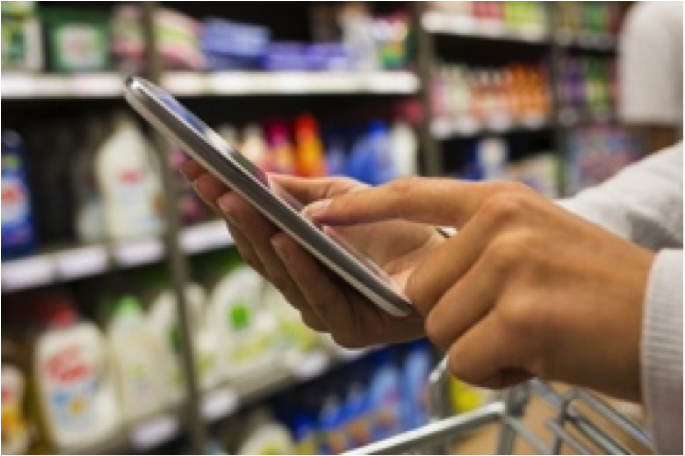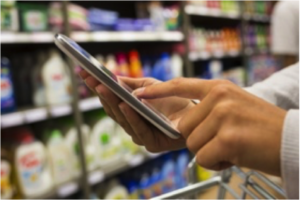


One of today’s rapidly evolving consumer trends is the omni-shopper and their ‘any time, any where’ purchasing habits. In a transcript of a recent podcast, Profitero’s Director of Strategy and Insights EMEA speaks to Craig Bradley, who runs a specialist shopper consultancy in the food and grocery sector.
Craig discusses the rise of convenience and discount retailers, why he believes Amazon is set to become the biggest player in online food and grocery retailing within the next 10 years, the importance for brands to target consumers based on their offline or online shopping preferences, as well as the growth of mobile commerce.
Q: First of all Craig, tell us just a little bit about yourself and what you’ve been up to over the last few years.
Seven years ago I started a specialist shopper consultancy in the food and grocery sector. It looks fairly niche on the outside, but as 60% of all retail is food and grocery it’s not particularly. We wanted to examine shoppers, rather consumers, so we’re specialists in this area, and that’s through all the different channels: online, convenience, supermarkets, the rise of the discounters, etc. Amazon is one of the key new players in the market, so we also look at what they do.
Q: One of the things that is talked about a lot is the omni-shopper, the online shopper, the offline shopper. What’s your view in terms of the way shoppers are behaving and the different methods they use?
You’re right to think that omni-shopping is the way forward, and many shoppers use just about all channels. We’re seeing people using both online and convenience stores across all age groups. It’s really a mix of shopper needs and why they use different channels, with the weather and seasons in the UK making quite a lot of difference to online shopping. There’s quite a lot of macro factors that affect why and who goes to the different channels.
What we have seen over recent years is the rise of convenience stores. Their numbers have multiplied beyond any expectations. A few years ago people thought that large store formats would dominate because of their selection, but shoppers have shunned the requirement to have lots of product to select from and are quite happy to go to a smaller store with convenience in mind. That really has driven the move toward discounters. Discounters have come into the market with smaller stores than traditional supermarkets.
The market is in uproar at the moment. I think all the cards are in the air of how the market eventually settles, but I think one thing is for sure: major supermarkets, the old super stores and hyper stores, are in such a decline that I can see in 20 years’ time we won’t have that sort of format.
Q: Obviously the discounters have had the biggest impact, and of course as and when they launch online, that will be really interesting. We also look at the difference between the traditional grocery sector, as you mentioned, and the elephant in the room that is Amazon. From your experience, and understanding shoppers, how do you see that affecting shopper behavior and the likelihood that Amazon will make a success within the grocery sector?
I think I’d put my house on Amazon being the biggest player in online food and grocery retail over the next 10 years. They currently take about 3% of the market in food and grocery but I just can’t see that their offering won’t be taken up by more and more consumers. The main advantage of course, is that a very high proportion of shoppers have an Amazon account to buy other products, so it’s no hardship or difficulty for them to add a few items that were traditionally only found within a food and grocery store. The other area where they’ve got a bigger advantage is the size of product they can deliver, so SKUs with very large quantity i.e 5-6 kilo washing powders, 1,000 tea bags, 48 toilet rolls – something that you would never normally see in a traditional store. Therefore the benefits of saving money, but also having a product you’re never going to run out of, is very reassuring to shoppers.

Q: It’s obviously important for brands to really understand the different between the way shoppers are buying their groceries at the moment and particular differences between online and offline shopping behavior. If there are brands listening who are really trying to understand these differences, from a purely research point of view, what’s the best way for them to start to understand their shopper online?
Hopefully they’ve already got some clear shopper segmentation, and therefore they understand what the buyers of their brand look like. It actually goes against what most people think an online grocery shopper looks like. They’re actually at the polar ends of the age group. You’ll see quite a lot of shoppers aged under 25, as you would expect. If your product is bought by that sort of group, then you really do need to make strides to make your products more appealing to buy online. What we also see is the silver surfer at the other end of the spectrum, who maybe from mobility problems, perhaps they don’t have a car anymore, actually have really grasped online shopping. They spend more time looking at online shops. Rather than a younger shopper who will be more in a rush to buy the items, they’ll spend a lot of time doing their shop, maybe up to 2 hours doing an online shop, rather than the 20-25 minutes that a younger shopper spends doing it.
Q: Once you’ve got this segmentation, then it’s really important to understand the specific behavior behind each one. Do you see any really good examples of brands that have taken a great shopper segmentation, particularly for the online world, and really changed their products accordingly?
I’ve seen it where they’ve changed their packaging to meet eCommerce needs, rather than changing the product itself. Packaging is so important. It’s relatively important in store, as standing out on a physical store is key, but when you’re looking at making your products stand out online, it’s really important to understand the scaling of your product. Let me give an example of maybe tea, where you’d have something that’s 8 inches square in real life. When it’s on a screen, it’s actually only 20mm by 17mm. When you get down to that size, clear packaging, clear messaging, clear understanding of the flavor, or the type of the product, is an absolute must, as people flick by product really, really quickly when they’re trying to search for something. The key is not necessarily the product, because the product’s not going to necessarily change online, but definitely the delivery of the packaging and how clear that would be.
A brand that’s done relatively well recently with a packaging change, and which was inspired by research into online behavior, is PG. If you see their new packaging it’s predominately white. The PG is the predominate words on the front. They’re not cluttered with any other information except for a color coded lid which denotes which flavor it is. If I was giving advice to anybody it would be that the size, the number of servings, the number of tea bags needs to be a lot clearer so you can differentiate between your brand and the rest of the market.
Q: I suppose the other area that’s usually important, particularly when we look at product images, is mobile shopping. What should brand be doing to make sure that the shopping experience on the mobile is as good as on a laptop or a tablet, or a PC?
We’ve seen that different digital devices are used in different ways as part of the shopper journey. It’s most common that a laptop or PC, but laptop predominately, will be used to initiate the shop. Using the laptop to get the majority of items, and get your slot is really important. After that, the role of the mobile phone, or the tablet, is really important because what we’re seeing a lot of is people augmenting their basket with products when they’re on the move, so maybe that’s on their commute to and from work, where they can think about buying two or three things, and adding them to an order they already have.
Q: In terms of the shopper experience, how are shoppers enjoying the mobile experience at the moment? Do you think most brands are getting it right, or is there still a bit of frustration in terms of difficulty in shopping from a very small screen?
Definitely the latter. You’re not going to do searches particularly for products. You’ve probably thought about the exact product you want when you’re using a device like a mobile phone, so rather than doing the whole shop, you’re just looking for specific items. That is more difficult. It’s virtually impossible, and some make you use the non-mobile site to then top up, which is just impossible to use. It doesn’t really grasp the functionality requirements of somebody topping up rather than doing a main shop. In my opinion, nobody’s really done a very good job in helping shoppers to really have lots of product online using their mobile.
Q: Another really interesting area, and one our customers are talking a lot about at the moment, is online media. Do you see any positive experience where brands are using online media, such as banners and promoting them on category pages, or is it just a very expensive way of getting your brand across?
Using the current example of how they are displayed, they are largely ignored. That’s only because when people are in shopper mode, when they’re doing their online shopping, their concentration is to do with finding product and adding that to their basket. Shoppers are also consumers and therefore they also do searches, often at a different time, or looking for inspiration, which isn’t part of their main shop. We often see a shopper may have a browse for half an hour around before they even think about doing a shop, but once they’re in shopper mode, they’re a lot less impactful.
I think the ability to capture a consumer when they’re doing some background research, or just some inspiration looking, and getting them to press a buy button which just adds into a basket which they may use later on, rather than actually going into transaction mode, is the way forward in my opinion.

Q: When you’re talking to the online shopper, they don’t know the advancements that are coming in a month or two months’ time. What sort of methods do you traditionally use to get their thoughts on the shopping experience online and what could be improved, or what they like or don’t like?
We get them to do searches, or go away to a site and try to find something, try to do something, but we don’t tell them specifically what we are researching. When we’re looking at trying to concept something, you need to think about investigating with the shopper whether the benefit of the new development is worth it, rather the development itself. We always hear about features and benefits of products, and too many times we try to sell the features rather than the benefits. Instead of saying, if we were using drones for example, “What would you think to a drone flying all the way and dropping something outside your house?” It would be nothing to do with the drone, because the drone actually is of no consequence, but: “What do you think about having a delivery within 30 minutes delivered to your door?” You have to put it more into something that a shopper would understand the benefit of, rather than the feature, the concept, the technology itself.
Q: What are the most important things that shoppers are saying would potentially encourage them to do more shopping online?
One of the key things for food brands is to ensure that the product they get delivered online is the same quality as if a shopper went into a store. That way it would be as fresh, if not fresher, and with a longer shelf life. Those sort of guarantees, which haven’t really been particularly good in the past about how your product’s going to be delivered, are really important.
It’s difficult for brands because online is run by the retailers who don’t do a particularly good job in customer service, or in packing, or in bringing it in the house, etc. and it’s so difficult for brands to overcome the problems which are more structural and lie with the retailer themselves.
Q: From what shoppers are saying, would delivery be the most important factor, or are there any other changing influences that are becoming more important for online shoppers?
Delivery’s the key. I think that having same-day delivery is definitely a way forward, if you order before a certain time. People waiting another day is quite a pain. We’ve done some research in the last four or five months in delivery slots with a brand, about how likely shoppers are to buy their products, and other products, with an hour delivery slot, and how much they would pay for shorter delivery. When you’re looking at brands, you’re running out of something, you have a recipe you’re trying to make and you just need one product, the ability to have that delivered within an hour, when you don’t have to leave the house and can continue to do your baking, cooking or whatever, is so important.
Consumers are actually willing to pay a premium for that. Let’s get away from the fact that people are thinking price is always important. The convenience of the delivery is really, really important and worth something. We tested whether they would have a free delivery the next day or pay £3 for a delivery within 2 hours, and the consensus for the brands we were doing it on behalf of was that they were quite happy to pay. The cost of delivery isn’t actually as important as the convenience.
Q: We’ve learned a lot today about understanding the shopper and important influences on online shopping. Any final elements, either for brands or retailers, on what they really should be doing to understand their shopper more, and then how they can use this insight to really drive their online sales?
One of the key issues I have, and other shoppers have, is that we’re exposed to the whole store. If I don’t have a baby, or a pet, or a garden, I don’t need to have those things available to me. If I am vegetarian, and I have an allergy to certain products, I want to tailor my store to ensure that only products that fit me are visible. I don’t want to see a big list of products that are blatantly not applicable to me as options.
The other thing would be to de-select brands that I wouldn’t consider. I want to tailor my category searches to only include those consideration brands. I want to be able to say, only show me PG teas. I don’t drink decaf, and I don’t drink fruit tea. It knows that from the start. I don’t have to cite that every time I shop. It’s intelligent. It knows that my selection is from a certain amount of products, and therefore it stops the problems of me having to troll through lots and lots of pages of products.
Yes, you could then interrupt me with the odd offer of something to tempt me away with a new product, but in essence, I want the site to meet my personality, my personalization, my exact requirements, and that is the big step forward. Instead of me seeing 24,000 SKUs, I actually only see 1,000 SKUs possible, and therefore everything I see is a lot easier to choose from. That’s one of the big, new improvements I would make.
Q: There’s so much talk about personalization, but it’s really interesting to hear from a shopping point of view. I think it will be a real challenge for a lot of brands, particularly smaller ones, how they react to that. How long do you think we’ll have to wait until we get that shopping experience that we’re looking for?
It could be tomorrow if the retailers wanted to do it. I once asked one of the big retailers, ‘why don’t you have a map of the store, so I know where I’ve been?’ because it’s very easy to miss categories out when you do online shopping, and I asked how quick could they do it. They told me they could do it tomorrow, but somebody else would have to do it first. They didn’t want to be the first. You can see that innovation with big retailers is actually quite poor. They’re actually in ‘I’ll follow you’ mode rather than ‘I’m going to innovate and do something different’.
Q: Thank you so much for joining us today Craig. Just finally, if people want to contact you and learn a bit more, what’s the best way of contacting you?
You can reach me through my LinkedIn, Craig Bradley.
To hear other industry thought leaders discuss the latest eCommerce trends impacting the CPG and retail sector today, listen to the Profitero Podcast Series.


























